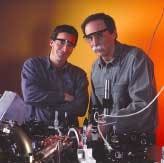Scalable method fixes quantum-computer errors
A method for automatically correcting data-handling errors in quantum computers, developed and demonstrated by physicists Dietrich Liebfried, David Wineland, and coworkers at the National Institute of Standards and Technology (NIST; Boulder, CO) presages a key process that will be necessary for scaling currently performed quantum logic operations up to the level of actual quantum information processing.1
Because quantum information cannot be observed without changing it, error-checking requires correlating or “entangling” the state of each data-carrying quantum bit (qubit) with ancillary or error-checking qubits, such that measurements on the ancillary qubits will reliably reflect changes of state in corresponding data qubits. Previously demonstrated methods for doing this have relied upon a liquid-state magnetic-resonance process that cannot be expanded efficiently to work with large numbers of qubits, and that also cannot be simply repeated using the same ancillary qubits. The NIST method, however, promises both scalability and repeatability.
The method was demonstrated using three beryllium ions-one data qubit and two ancillary error checkers-confined to the axis of a trap that confines ions using inhomogeneous electric fields oscillating at radio frequencies. The qubit information consisted of two hyperfine states (spin up and spin down) of beryllium ions, manipulated using laser pulses. The experiment consisted of a series of laser-pulse-stimulated quantum-logic operations: first, setting the state of the primary or data cubit; second, performing a quantum “entangling” operation to encode the entire system (all three qubits) with the state of the data qubit; third, creating an error-generating disturbance throughout the entire system using a laser-induced stimulated-Raman transition; fourth, decoding the system, or disentangling the qubits and spatially separating ancillary qubits from the data qubit; fifth, querying the ancillary qubits to ascertain if an error had actually occurred in the data state; and last, applying a correction to the data qubit based on the information obtained from the ancillary qubits.
In testing their error-correction method, the researchers observed that it was not infallible, largely because of technical imperfections in the quantum encoding and decoding operations (fidelity on the order of 90%). But they asserted that the overall experimental results demonstrated the feasibility of quantum error correction in an efficiently scalable and resettable system, and that such a system could eventually be achieved with implementation of technical improvements to provide higher operational fidelity.
REFERENCE
1. J. Chiaverni et al., Nature 432(7017) 602 (Dec. 2, 2004).

